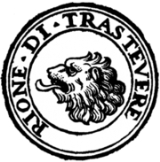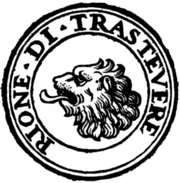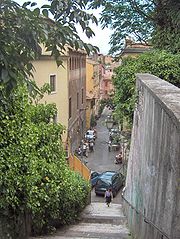
Trastevere
Encyclopedia



Rioni of Rome
A rione is an Italian term used since the Middle Ages to name the districts of Rome, according to the administrative divisions of that time. The word originates from the Latin word regio A rione (pl. rioni) is an Italian term used since the Middle Ages to name the districts of Rome, according to...
XIII of Rome
Rome
Rome is the capital of Italy and the country's largest and most populated city and comune, with over 2.7 million residents in . The city is located in the central-western portion of the Italian Peninsula, on the Tiber River within the Lazio region of Italy.Rome's history spans two and a half...
, on the west bank of the Tiber
Tiber
The Tiber is the third-longest river in Italy, rising in the Apennine Mountains in Emilia-Romagna and flowing through Umbria and Lazio to the Tyrrhenian Sea. It drains a basin estimated at...
, south of Vatican City
Vatican City
Vatican City , or Vatican City State, in Italian officially Stato della Città del Vaticano , which translates literally as State of the City of the Vatican, is a landlocked sovereign city-state whose territory consists of a walled enclave within the city of Rome, Italy. It has an area of...
. Its name comes from the Latin
Latin
Latin is an Italic language originally spoken in Latium and Ancient Rome. It, along with most European languages, is a descendant of the ancient Proto-Indo-European language. Although it is considered a dead language, a number of scholars and members of the Christian clergy speak it fluently, and...
trans Tiberim, meaning literally "beyond the Tiber". The correct pronunciation is "tras-TEH-ve-ray", with the accent on the second syllable. Its logo is a golden head of a lion
Lion
The lion is one of the four big cats in the genus Panthera, and a member of the family Felidae. With some males exceeding 250 kg in weight, it is the second-largest living cat after the tiger...
on a red background, the meaning of which is uncertain. To the north, Trastevere borders on to the XIV rione, Borgo
Borgo (rione of Rome)
Borgo , is the 14th historic district of Rome, Italy. It lies on the west bank of the Tiber, and has a trapezoidal shape. Its coat of arms shows a lion , lying in front of three mounts and a star...
.
History
In RomeRome
Rome is the capital of Italy and the country's largest and most populated city and comune, with over 2.7 million residents in . The city is located in the central-western portion of the Italian Peninsula, on the Tiber River within the Lazio region of Italy.Rome's history spans two and a half...
's Regal period
Roman Kingdom
The Roman Kingdom was the period of the ancient Roman civilization characterized by a monarchical form of government of the city of Rome and its territories....
(753-509 BC), the area across the Tiber belonged to the hostile Etruscans: the Romans named it Ripa Etrusca (Etruscan bank). Rome conquered it to gain control of and access to the river from both banks, but was not interested in building on that side of the river. In fact, the only connection between Trastevere and the rest of the city was a small wooden bridge called the Pons Sublicius
Pons Sublicius
The earliest known bridge of ancient Rome, Italy, the Pons Sublicius, spanned the Tiber River near the Forum Boarium downstream from the Tiber Island, near the foot of the Aventine Hill. According to tradition, its construction was ordered by Ancus Martius around 642 BC, but this date is...
(Latin: "bridge built on wooden piles").
By the time of the Republic
Roman Republic
The Roman Republic was the period of the ancient Roman civilization where the government operated as a republic. It began with the overthrow of the Roman monarchy, traditionally dated around 508 BC, and its replacement by a government headed by two consuls, elected annually by the citizens and...
c. 509 BC, the number of sailors and fishermen making a living from the river had increased, and many had taken up residence in Trastevere. Immigrants from the East also settled there, mainly Jews and Syrians
Demographics of Syria
Syrians today are an overall indigenous Levantine people. While modern-day Syrians are commonly described as Arabs by virtue of their modern-day language and bonds to Arab culture and history...
. The area began to be considered part of the city under Augustus
Augustus
Augustus ;23 September 63 BC – 19 August AD 14) is considered the first emperor of the Roman Empire, which he ruled alone from 27 BC until his death in 14 AD.The dates of his rule are contemporary dates; Augustus lived under two calendars, the Roman Republican until 45 BC, and the Julian...
, who divided Rome into 14 regions
14 regions of the Augustan Rome
In 7 BC, Augustus divided the city of Rome into 14 administrative regions . These replaced the four regiones or "quarters" traditionally attributed to Servius Tullius, sixth King of Rome. They were further divided into official neighborhoods ...
(regiones in Latin); modern Trastevere was the XIV and was called Trans Tiberim.
Since the end of the Roman Republic the quarter was also the center of an important Jewish
Jews
The Jews , also known as the Jewish people, are a nation and ethnoreligious group originating in the Israelites or Hebrews of the Ancient Near East. The Jewish ethnicity, nationality, and religion are strongly interrelated, as Judaism is the traditional faith of the Jewish nation...
community, which inhabited there until the end of the Middle Ages.
With the wealth of the Imperial Age, several important figures decided to build their villae
Roman villa
A Roman villa is a villa that was built or lived in during the Roman republic and the Roman Empire. A villa was originally a Roman country house built for the upper class...
in Trastevere, including Clodia
Clodia
Clodia, Clodia, Clodia, (born Claudia Pulchra Prima or Maior or also Quadrantaria c. 95 BC or c. 94 BC and often referred to in scholarship as Clodia Metelli ("Clodia the wife of Metellus"), was the third daughter of the patrician Appius Claudius Pulcher and Caecilia Metella Balearica.She is not to...
, (Catullus
Catullus
Gaius Valerius Catullus was a Latin poet of the Republican period. His surviving works are still read widely, and continue to influence poetry and other forms of art.-Biography:...
' "friend") and Julius Caesar
Julius Caesar
Gaius Julius Caesar was a Roman general and statesman and a distinguished writer of Latin prose. He played a critical role in the gradual transformation of the Roman Republic into the Roman Empire....
(his garden villa, the Horti Caesaris). The regio included two of the most ancient churches in Rome, the Titulus Callixti, later called the Basilica di Santa Maria in Trastevere, and the Titulus Cecilae, Santa Cecilia in Trastevere
Santa Cecilia in Trastevere
Santa Cecilia in Trastevere is a 5th century church in Rome, Italy, devoted to Saint Cecilia, in the Trastevere rione.-History:The first church on this site was founded probably in the 3rd century, by Pope Urban I; it was devoted to the Roman martyr Cecilia, martyred it is said under Marcus...
.
In order to have a stronghold on the right Bank and to control the Gianicolo hill, Transtiberim was partially included by Emperor Aurelian
Aurelian
Aurelian , was Roman Emperor from 270 to 275. During his reign, he defeated the Alamanni after a devastating war. He also defeated the Goths, Vandals, Juthungi, Sarmatians, and Carpi. Aurelian restored the Empire's eastern provinces after his conquest of the Palmyrene Empire in 273. The following...
(270–275) inside the wall
Aurelian Walls
The Aurelian Walls is a line of city walls built between 271 and 275 in Rome, Italy, during the reign of the Roman Emperors Aurelian and Probus....
erected to defend the city against the Germanic tribes.
In the Middle Ages
Middle Ages
The Middle Ages is a periodization of European history from the 5th century to the 15th century. The Middle Ages follows the fall of the Western Roman Empire in 476 and precedes the Early Modern Era. It is the middle period of a three-period division of Western history: Classic, Medieval and Modern...
Trastevere had narrow, winding, irregular streets; moreover, because of the mignani (structures on the front of buildings) there was no space for carriages to pass. At the end of the 15th century these mignani were removed. Nevertheless, Trastevere remained a maze of narrow streets. There was a strong contrast between the large, opulent houses of the upper classes and the small, dilapidated houses of the poor. The streets had no pavement until the time of Sixtus IV at the end of the 15th century. At first bricks were used, but these were later replaced by sampietrini
Sampietrini
Sampietrini is the typical kind of pavement found in the centre of Rome, Italy. It is made of tiles of black porphyry , placed one next to the other...
(cobble stones), which were more suitable for carriages. Thanks to its partial isolation (it was "beyond the Tiber") and to the fact that it its population had been multicultural since the ancient Roman period, the inhabitants of Trastevere, called Trasteverini, developed a culture of their own. In 1744 Benedict XIV modified the borders of the rioni, giving Trastevere its modern limits.
Modern day
Nowadays, Trastevere maintains its character thanks to its narrow cobbled streets lined by medieval houses. At night, both natives and tourists alike flock to its many pubs and restaurants. However, much of the original character of Trastevere remains. The area is also home to John Cabot UniversityJohn Cabot University
John Cabot University is a private American liberal arts university located in Rome, Italy. Founded in 1972, it was named after the Italian explorer Giovanni Caboto.-Location:...
, a private American University, the American Academy in Rome
American Academy in Rome
The American Academy in Rome is a research and arts institution located on the Gianicolo in Rome.- History :In 1893, a group of American architects, painters and sculptors met regularly while planning the fine arts section of the 1893 World's Columbian Exposition...
, and the Rome campus of the Thomas More College of Liberal Arts
Thomas More College of Liberal Arts
The Thomas More College of Liberal Arts is located in Merrimack, New Hampshire. The college emphasizes classical education in the Roman Catholic intellectual tradition and is named after Thomas More. The school has approximately 100 students.-Founding:...
, the Canadian University of Waterloo School of Architecture
University of Waterloo School of Architecture
The School of Architecture is one of the professional schools of the University of Waterloo. It offers a professional program in architecture accredited by the Canadian Architectural Certification Board at the master's level . It is part of the Faculty of Engineering and is located on a satellite...
(between the months of September and December), and the American Pratt Institute
Pratt Institute
Pratt Institute is a private art college in New York City located in Brooklyn, New York, with satellite campuses in Manhattan and Utica. Pratt is one of the leading undergraduate art schools in the United States and offers programs in Architecture, Graphic Design, History of Art and Design,...
School of Architecture therefore serving as home to an international student body.
The unique character of this neighborhood has attracted artists, foreign expats, and many famous people. In the sixties and seventies, the American musicians/composers Frederic Rzewski and Richard Teitelbaum
Richard Teitelbaum
Richard Teitelbaum is an American composer, keyboardist, and improvisor. Born in New York, he is a former student of Allen Forte, Mel Powell, and Luigi Nono. He is best known for his live electronic music and synthesizer performance. For example, he brought the first moog synthesizer to Europe...
, of the group Musica Elettronica Viva
Musica Elettronica Viva
Musica Elettronica Viva is a live acoustic/electronic improvisational group formed in Rome, Italy, in 1966. Over the years, its members have included Alvin Curran, Richard Teitelbaum, Frederic Rzewski, Allan Bryant, Carol Plantamura, Ivan Vandor, Steve Lacy, and Jon Phetteplace.They were early...
, lived in Via della Luce. Sergio Leone
Sergio Leone
Sergio Leone was an Italian film director, producer and screenwriter most associated with the "Spaghetti Western" genre.Leone's film-making style includes juxtaposing extreme close-up shots with lengthy long shots...
, the director of Spaghetti Westerns, grew up in Viale Glorioso (there is a marble plaque to his memory on the wall of the apartment building), and went to a Catholic private school in the neighborhood. Ennio Morricone
Ennio Morricone
Ennio Morricone, Grand Officer OMRI, , is an Italian composer and conductor, who wrote music to more than 500 motion pictures and television series, in a career lasting over 50 years. His scores have been included in over 20 award-winning films as well as several symphonic and choral pieces...
, the film music composer, went to the same school, and for one year was in the same class as Sergio Leone.

